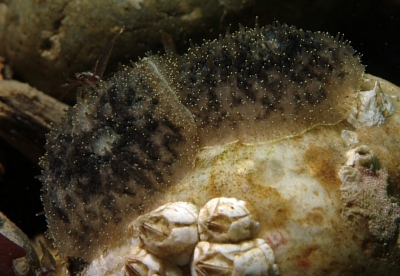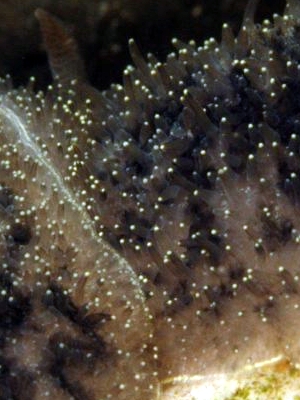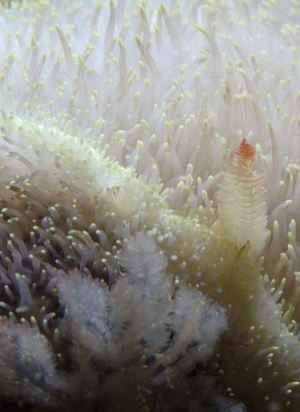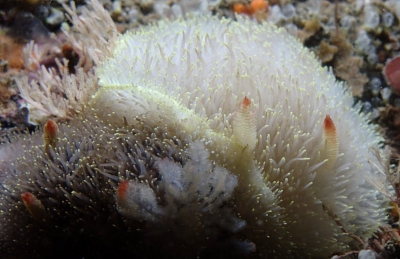Acanthodoris hudsoni color variation?
February 12, 2007
From: Pete Naylor

I have seen a number of dorids with all the identifying features of Acanthodoris hudsoni (yellow rhinopore tips and foot margin etc) but a darker mottled base. Often times I see these in the same area as more typical examples of Acanthodoris hudsoni, and they are generally very near or in contact with a second specimen. I am wondering if this coloration is related to reproductive activity or if this is actually a different species that I haven't been able to find in my books.
FWIW, I have also seen similar color variations in the very similar Acanthodoris nanaimoensis - though in those cases I've generally noted a bluish hue to one specimen while the other retained the white base color.
I've attached a photos to illustrate both the observations above. Sorry if this is in fact two separate species - I'm including both photos because I'm just not sure.
Locality: Admiralty Inlet, Puget Sound, 40 feet, Washington, USA, Northeastern Pacific Ocean, 13 January 2007, Submerged rock formation.. Length: 1.5 inches. Photographer: Pete Naylor.
Pete Naylor
pete@geckoworks.com



Hi Pete,
To answer your question right off, all of these specimens are in fact Acanthodoris nanaimoensis. The important give-away when you see these darker pigmented, mottled specimens, is that the tips of the rhinophores and/or gills have some degree of red wine color, as shown in the close-up alongside.
As you are aware, Acanthodoris hudsoni has a white body with yellow at the tips of the dorsal papillations, rhinophores and gills. But there is never any wine colored pigmentation. Both species have a yellow marginal line.
Photographs of both color phases of A. nanaimoensis can be found in Lamb & Hanby, page 255 top, insert, and my very first edition of Pacific Coast Nudibranchs, (1980, blue cover), page 49.
Some of my colleagues have suggested that if your start with A. pilosa, and move to A. hudsoni, then to A. nanaimoensis and A. rhodoceras, we have a single species with very wide color variation, from white to dark, no color on tips to red then black. Food for thought.
-
Lamb, A. & B.P. Hanby. (2005) Marine Life of the Pacific Northwest. Harbour Publishing.
-
Behrens, D.W. (1980) Pacific Coast Nudibranchs. Sea Challengers Publishing.
Thanks for sharing these,
Dave Behrens
Related messages
-
Re: Grey colour form of Acanthodoris nanaimoensis
From: Susan E. Glarum, July 31, 2008 -
Acanthodoris spp in Puget Sound
From: Jan Kocian, March 6, 2006 -
Re: Trailing Dorids
From: Jan Kocian, March 2, 2006 -
Acanthodoris nanaimoensis from British Columbia
From: Marli Wakeling, November 10, 2005 -
Grey colour form of Acanthodoris nanaimoensis
From: Jan Kocian, November 10, 2005 -
Acanthodoris nanaimoensis from British Columbia
From: Marli Wakeling, January 2, 2005 -
Acanthodoris nanaimoensis from British Columbia
From: Bruce Wight, October 23, 2003 -
Acanthodoris nanaimoensis from British Columbia
From: Marli Wakeling, April 1, 2002 -
Acanthodoris nanaimoensis from Oregon
From: Jeff Goddard, December 30, 2000
